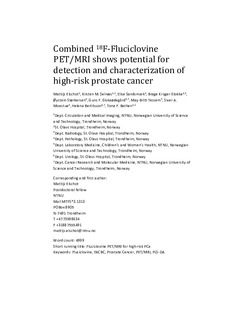| dc.description.abstract | The objective of this study is to investigate if quantitative imaging features derived from combined 18F-Fluciclovine Positron Emission Tomograpy (PET) / multiparametric Magnetic Resonance Imaging (MRI) show potential for detection and characterization of primary prostate cancer. Methods: Twenty-eight (28) patients diagnosed with high-risk prostate cancer underwent simultaneous 18F-Fluciclovine PET/MRI before radical prostatectomy. Volumes-of-interest (VOIs) of prostate tumors, benign prostatic hyperplasia (BPH) nodules, prostatitis, and healthy tissue were delineated on T2-weighted images using histology as a reference. Tumor VOIs were marked as high-grade (≥ Gleason Grade group 3) or not. MRI and PET features were extracted on the voxel and VOI-level. Partial least-squared discriminant analysis (PLS-DA) with double leave-one-patient-out cross validation was performed to classify tumor from benign tissue (BPH, prostatitis, healthy tissue) and high-grade tumor from other tissue (low-grade tumor, benign tissue). The performances of PET, MRI, and combined PET/MRI features were compared using the area under the receiver operating characteristic curve (AUC). Results: Voxel and VOI features were extracted from 40 tumor (26 high-grade), 36 BPH, 6 prostatitis, and 37 healthy tissue VOIs. PET/MRI performed better than MRI and PET for classification of tumor vs benign tissue (voxel: AUC 87%, 81%, and 83%; VOI: AUC 96%, 93%, and 93%, respectively) and high-grade tumor vs other tissue (voxel: AUC 85%, 79%, and 81%; VOI: AUC 93%, 93%, and 91%, respectively). T2-weighted MRI, diffusion-weighted MRI and PET features were most important for classification. Conclusion: Combined 18F-Fluciclovine PET/multiparametric MRI shows potential for improving detection and characterization of high-risk prostate cancer, in comparison to MRI and PET alone. | nb_NO |
